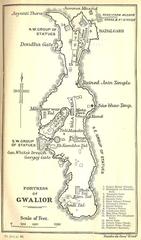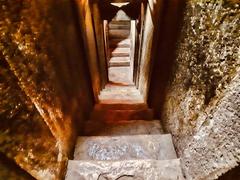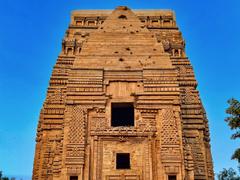
Gopachal Rock-Cut Jain Monuments: Visiting Hours, Tickets, and Travel Guide – Gwalior Historical Sites
Date: 04/07/2025
Introduction
The Gopachal Rock-Cut Jain Monuments, embedded in the sandstone cliffs within the formidable Gwalior Fort in Madhya Pradesh, India, represent one of the most significant and expansive collections of Jain rock-cut sculptures in the country. Spanning from the 7th to the 15th centuries CE, these monuments capture the spiritual ideals of Jainism and showcase the artistry and religious pluralism of medieval India. With more than 1,000 statues—including colossal depictions of all 24 Tirthankaras—the site offers a profound journey into Jain philosophy, Indian art, and cultural synthesis. This comprehensive guide covers historical context, artistic highlights, visiting hours, ticketing information, travel tips, and practical advice to help you make the most of your visit (ASI, 2024; Madhya Pradesh Tourism, 2024).
Table of Contents
- Historical Background
- Religious Harmony and Cultural Synthesis
- Pilgrimage and Ritual Life
- Monumental Scale and Layout
- Iconography and Artistic Details
- Visiting Hours and Tickets
- Accessibility and Visitor Info
- Travel Tips and How to Reach
- Facilities and Amenities
- Nearby Attractions
- Guided Tours and Special Events
- Safety, Etiquette, and Responsible Tourism
- Frequently Asked Questions (FAQ)
- Conclusion
- References
Historical Background
Early Origins and Patronage
The origins of the Gopachal Rock-Cut Jain Monuments trace back to the late 7th century CE, with substantial expansion during the Gurjara-Pratihara dynasty (8th–11th centuries CE) and artistic flourishing under the Tomar rulers in the 15th century (ASI, 2024). The Tomars, especially Dungar Singh and Kirti Singh, commissioned many of the monumental sculptures and reliefs (Jain, 2018).
Architectural Features and Artistic Styles
The site comprises over 1,000 Jain sculptures carved directly into the cliffs, grouped into clusters such as Siddhachal and Urvai Gate. The statues vary in size—from small reliefs to the imposing 17-meter-high idol of Lord Parshvanatha (Madhya Pradesh Tourism, 2024). The art is characterized by meditative postures, serene expressions, minimal ornamentation (hallmarks of the Digambara sect), and intricate reliefs around the Tirthankaras (ASI, 2024).
Inscriptions in Sanskrit and Prakrit, primarily from the 15th century, detail patronage and social context (Jain, 2018).
Religious and Cultural Significance
Gopachal has long served as a major Jain pilgrimage center, reflecting Gwalior’s religious diversity and importance to Jain doctrine, especially for the Digambara tradition (Madhya Pradesh Tourism, 2024).
Preservation and Historical Challenges
During the Mughal era, particularly under Babur, many sculptures were damaged or defaced (Baburnama, 16th c.). Restoration efforts by the Jain community and the Archaeological Survey of India have since preserved and stabilized much of the site (ASI, 2024).
Context in Indian Rock-Cut Architecture
Gopachal is a key example of India’s rock-cut heritage, standing alongside Ajanta, Ellora, Udayagiri, and Khandagiri—distinguished by its concentration of monumental Jain imagery (UNESCO, 2024).
Religious Harmony and Cultural Synthesis
The Gopachal monuments are situated near Hindu temples like Teli Ka Mandir and Sas Bahu Temples, reflecting centuries of religious coexistence and cultural exchange (theworldcastle.com). The proximity of Jain and Hindu sites within the fort complex underscores Gwalior’s pluralistic legacy.
Pilgrimage and Ritual Life
Gopachal is a vital destination for Jain pilgrimage, with statues such as the 58-foot Lord Adinath (Rishabhanatha) serving as focal points for worship, meditation, and festive rituals. Major celebrations include Mahavir Jayanti and Paryushana, during which devotees perform abhisheka (ritual bathing), prayers, and offerings (theworldcastle.com).
Monumental Scale and Layout
Gopachal consists of five main clusters, with the Siddhachal group housing statues from 5 feet (1.5 meters) up to 47 feet (14.3 meters) tall (Kevin Standage Photography; Wikipedia). The colossal Parshvanatha idol is among the tallest Jain rock-cut images in India (Explore My Ways; Poojn.in).
Iconography and Artistic Details
The sculptures depict the Tirthankaras in padmasana (seated lotus) and kayotsarga (standing meditation) postures, often nude as per Digambara tradition. Iconic motifs—such as the lion for Mahavira and serpent hoods for Parshvanatha—aid identification. Surrounding reliefs feature attendants, celestial beings, and auspicious Jain symbols (Wikipedia; Explore My Ways).
Visiting Hours and Tickets
- Fort Hours: 8:00 AM to 6:00 PM daily
- Monument Hours: 9:30 AM to 5:30 PM (some clusters may close earlier)
- Entry Fees:
- Indian Citizens: ₹25
- Foreign Nationals: ₹250
- Children under 15: Free
- Camera Charges: ₹25
- Light & Sound Show: ₹75 per person (within fort complex)
Tickets are available at the fort entrance or via the Madhya Pradesh Tourism website.
Accessibility and Visitor Info
- Terrain: Uneven paths and steep steps; vehicle access via Urvai Gate is recommended for those with mobility challenges.
- Facilities: Basic restrooms near main entrances; limited food and water options within the monument area.
- Attire: Modest clothing is advised; shoe removal may be required in certain areas.
- Photography: Allowed with camera fee; flash and tripods may be restricted (Poojn.in).
- Accessibility: Limited for wheelchair users; assistance recommended.
Travel Tips and How to Reach
- Best Time to Visit: October to March for pleasant weather.
- By Train: Gwalior Railway Station (3 km from fort).
- By Air: Gwalior Airport (12 km from the fort).
- By Road: Well-connected by highways; local taxis and autos are available.
- Start Early: To avoid crowds and midday heat; carry water and snacks.
Facilities and Amenities
- Licensed guides are available for detailed tours.
- Rest areas and some drinking water points are near main clusters.
- Official souvenir shops and local vendors offer mementos.
Nearby Attractions
- Gwalior Fort: Palaces, museums, and temples within walking distance.
- Sas Bahu Temples: Notable for their intricate carvings.
- Jai Vilas Palace: Showcasing royal heritage.
- Tigra Dam & Gwalior Zoo: Short drives from the fort.
Guided Tours and Special Events
- Guided tours are available at the fort entrance.
- Annual Jain festivals attract pilgrims and cultural enthusiasts.
Safety, Etiquette, and Responsible Tourism
- Do not touch or climb the sculptures.
- Maintain silence and respect during rituals.
- Smoking, alcohol, and littering are prohibited.
- Support conservation by hiring local guides and using official services.
Frequently Asked Questions (FAQ)
Q1: What are the Gopachal Rock-Cut Jain Monuments visiting hours?
A1: Open from 9:30 AM to 5:30 PM daily; fort hours are 8:00 AM to 6:00 PM.
Q2: Where can I buy tickets?
A2: At the fort entrance or via the official tourism website.
Q3: Is the site wheelchair accessible?
A3: Accessibility is limited due to uneven paths; vehicles can reach Urvai Gate to minimize walking.
Q4: Are guided tours available?
A4: Yes, guides can be hired at the entrance.
Q5: Can I take photographs?
A5: Yes, with a camera fee; follow restrictions on flash and tripods.
Conclusion
The Gopachal Rock-Cut Jain Monuments are a majestic confluence of religious devotion, artistic excellence, and historical resilience. Their colossal sculptures and serene iconography narrate the enduring legacy of Jainism and India’s tradition of religious harmony. With practical visitor information—covering hours, tickets, accessibility, and etiquette—this guide equips you to experience one of Gwalior’s most treasured sites. Embrace responsible tourism and help preserve these ancient wonders for future generations. For updates and personalized tips, visit official tourism portals and consider the Audiala app.
References
- Archaeological Survey of India – Gopachal Parvat Jain Monuments
- Madhya Pradesh Tourism – Gopachal Parvat
- Gwalior Fort: Exploring Its Cultural and Religious Significance – The World Castle
- The Rock-cut Jain Monuments of Gwalior – Kevin Standage Photography
- Rock-Cut Jain Temples & Sculptures, Gopachal Parvat – Explore My Ways
- Siddhachal Caves: Your 2025 Guide – Poojn.in
- Baburnama (16th century) – Babur









